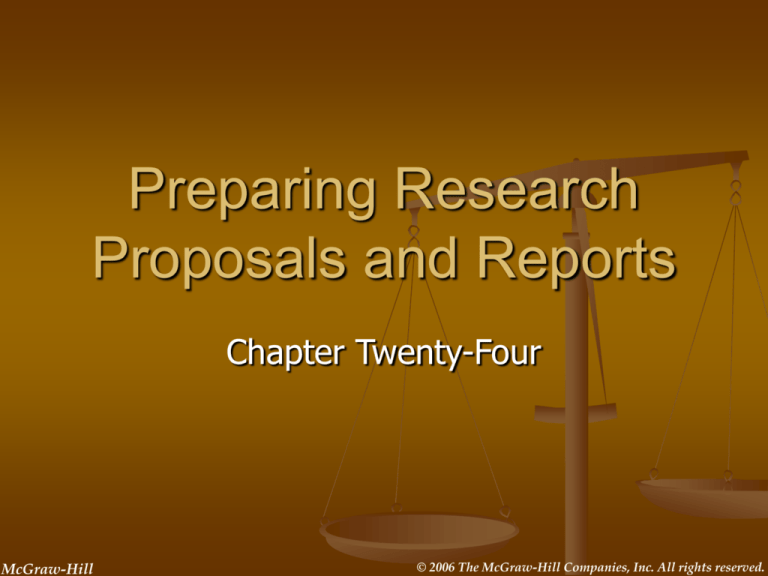
Preparing Research
Proposals and Reports
Chapter Twenty-Four
McGraw-Hill
© 2006 The McGraw-Hill Companies, Inc. All rights reserved.
Preparing Research Proposals and Reports
Chapter Twenty-Four
McGraw-Hill
© 2006 The McGraw-Hill Companies, Inc. All rights reserved.
What is a Research Proposal?
It is a written plan of a study.
It spells out in detail what the researcher intends
to do.
It permits others to learn about the intended
research and to offer suggestions for improving
the study.
It also helps the researcher clarify what needs to
be done and to avoid unintentional problems.
McGraw-Hill
© 2006 The McGraw-Hill Companies, Inc. All rights reserved.
The Major Sections of a Research Proposal
There are four topics addressed in this area:
1)
2)
3)
4)
The purpose of the study
The justification for the study
The research question/hypothesis, including
variables to be investigated
The definition of terms
See Figure 24.1, Organization of a Research Report.
McGraw-Hill
© 2006 The McGraw-Hill Companies, Inc. All rights reserved.
Organization of a Research Report (1)
(Figure 24.1)
Introductory section
Title Page
Table of Contents
List of Figures
List of Tables
Main Body
I. Problem to be investigated
A. Purpose of the study (including assumptions)
B. Justification of the study
C. Research question and hypotheses
D. Definition of terms
E. Brief overview of study
II. Background and review of related literature
A. Theory, if appropriate
B. Studies directly related
C. Studies tangentially related
III. Procedures
A. Description of the research design
B. Description of the sample
C. Description of the instruments used
(including scoring procedures)
McGraw-Hill
© 2006 The McGraw-Hill Companies, Inc. All rights reserved.
Organization of a Research Report (2)
(Figure 24.1)
D. Explanation of the procedures followed (the
what, when, where, and how of the study)
E. Discussion of internal validity
F. Discussion of external validity
G. Description and justification of the statistical
techniques or other methods of analysis used
IV. Findings
Description of findings pertinent to each of the
research hypotheses or questions
V. Summary and conclusions
A. Brief summary of the research question being
investigated, the procedures employed, and
the results obtained
B. Discussion of the implications of the
findings—their meaning and significance
C. Limitations—unresolved problems and
weaknesses
D. Suggestions for further research
References (Bibliography)
Appendixes
McGraw-Hill
© 2006 The McGraw-Hill Companies, Inc. All rights reserved.
Purpose of the Study
The purpose states succinctly what the researcher
proposes to investigate.
This should be a concise statement, providing a
framework to which details are added later.
Clarification of the field of interest should be considered
here.
McGraw-Hill
© 2006 The McGraw-Hill Companies, Inc. All rights reserved.
Justification of the Study
The researcher must make clear why this particular study
is important to investigate.
He or she must present an argument for the study.
A good justification should also include any specific
implications that follow if relationships are identified.
There could be an implication that current methods are
not good enough, however, this should be made explicit.
McGraw-Hill
© 2006 The McGraw-Hill Companies, Inc. All rights reserved.
Research Question or Hypothesis
The particular question to be investigated should
be stated here.
Favoring hypotheses will help clarify and become
a strategy point.
It should be clearly stated as concisely as
possible.
There should be any inference made if a
hypothesis is well-stated.
McGraw-Hill
© 2006 The McGraw-Hill Companies, Inc. All rights reserved.
Definitions
All key terms should be defined.
The researcher’s task is to make the definitions
as clear as possible.
Sometimes, terms will have to be modified to fit
the present study.
While it is probably impossible to eliminate all
ambiguity, the clearer the terms used, the fewer
the difficulties that will be encountered with the
study.
McGraw-Hill
© 2006 The McGraw-Hill Companies, Inc. All rights reserved.
Background and Review of Literature
This may be a lengthy section since it is a partial
summary of previous work related to the focus of the
study.
The researcher should demonstrate a familiarity with
previous research and understand the relevance of the
study being planned.
A major weakness of many literature reviews is that they
cite references without indicating their implications for
the planned study.
McGraw-Hill
© 2006 The McGraw-Hill Companies, Inc. All rights reserved.
Procedures
The procedures section includes discussion of the
following:
McGraw-Hill
Research Design
Sample
Instrumentation
Procedural detail
Internal validity
Data analysis
© 2006 The McGraw-Hill Companies, Inc. All rights reserved.
Results/Findings
Results of a study can be presented only in a research
report.
Results are usually not found in the proposal section.
This section is found near the end of the research report
and constitutes the description of what kind of analyses
were performed.
The data are revealed by the form of statistical analysis
that was applied to the data, and any significance that
was observed.
McGraw-Hill
© 2006 The McGraw-Hill Companies, Inc. All rights reserved.
Discussion
The discussion section of a report presents the author’s
interpretation of what the results imply for theory and/or
practice.
Researchers place their results in a broader context.
Here, difficulties as well as limitations of the study are
noted, and suggestions for future considerations are
included.
Results and Discussion sections should be kept separate,
since the Discussion section goes beyond the data.
McGraw-Hill
© 2006 The McGraw-Hill Companies, Inc. All rights reserved.
General Rules to Consider
A research report should be written as clearly and
concisely as possible.
Research reports are always written in the past tense
and free from jargon.
A style manual (APA manual) should be consulted
before beginning the report.
Once the report is completed, it is a good idea to have
a thesis formatter/editor check for style and grammar.
Computerized programs have made research reports
easier to complete, due to self-correcting programs.
McGraw-Hill
© 2006 The McGraw-Hill Companies, Inc. All rights reserved.






